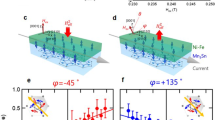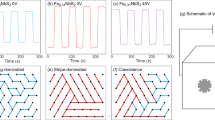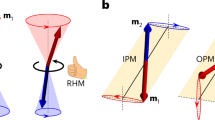Abstract
Electric field control of spin–orbit torque in ferromagnets1 has been intensively pursued in spintronics to achieve efficient memory and computing devices with ultralow energy consumption. Compared with ferromagnets, antiferromagnets2,3 have huge potential in high-density information storage because of their ultrafast spin dynamics and vanishingly small stray field4,5,6,7. However, the manipulation of spin–orbit torque in antiferromagnets using electric fields remains elusive. Here we use ferroelastic strain from piezoelectric materials to switch the uniaxial magnetic anisotropy in antiferromagnetic Mn2Au films with an electric field of only a few kilovolts per centimetre at room temperature. Owing to the uniaxial magnetic anisotropy, we observe an asymmetric Néel spin–orbit torque8,9 in the Mn2Au, which is used to demonstrate an antiferromagnetic ratchet. The asymmetry of the Néel spin–orbit torque and the corresponding antiferromagnetic ratchet can be reversed by the electric field. Our finding sheds light on antiferromagnet-based memories with ultrahigh density and high energy efficiency.
This is a preview of subscription content, access via your institution
Access options
Access Nature and 54 other Nature Portfolio journals
Get Nature+, our best-value online-access subscription
$29.99 / 30 days
cancel any time
Subscribe to this journal
Receive 12 print issues and online access
$259.00 per year
only $21.58 per issue
Buy this article
- Purchase on Springer Link
- Instant access to full article PDF
Prices may be subject to local taxes which are calculated during checkout




Similar content being viewed by others
Data availability
The data that support the plots within this paper and other findings of this study are available from the corresponding author on reasonable request.
References
Cai, K. M. et al. Electric field control of deterministic current-induced magnetization switching in a hybrid ferromagnetic/ferroelectric structure. Nat. Mater. 16, 712–716 (2017).
Jungwirth, T., Marti, X., Wadley, P. & Wunderlich, J. Antiferromagnetic spintronics. Nat. Nanotechnol. 11, 231–241 (2016).
Baltz, V. et al. Antiferromagnetic spintronics. Rev. Mod. Phys. 90, 015005 (2018).
Park, B. G. et al. A spin-valve-like magnetoresistance of an antiferromagnet-based tunnel junction. Nat. Mater. 10, 347–351 (2011).
Qiu, Z. Y. et al. Spin colossal magnetoresistance in an antiferromagnetic insulator. Nat. Mater. 17, 577–580 (2018).
Marti, X. et al. Room-temperature antiferromagnetic memory resistor. Nat. Mater. 13, 367–374 (2014).
Lebrun, R. et al. Tunable long-distance spin transport in a crystalline antiferromagnetic iron oxide. Nature 561, 222–225 (2018).
Wadley, P. et al. Electrical switching of an antiferromagnet. Science 351, 587–590 (2016).
Bodnar, S. Y. et al. Writing and reading antiferromagnetic Mn2Au by Néel spin–orbit torques and large anisotropic magnetoresistance. Nat. Commun. 9, 348 (2018).
Slonczewski, J. C. Current-driven excitation of magnetic multilayers. J. Magn. Magn. Mater. 159, L1–L7 (1996).
Liu, L. Q. et al. Spin-torque switching with the giant spin Hall effect of tantalum. Science 336, 555–558 (2012).
Parkin, S. S. P. et al. Exchange-biased magnetic tunnel junctions and application to nonvolatile magnetic random access memory. J. Appl. Phys. 85, 5828–5833 (1999).
Wang, W. G., Li, M. E., Hageman, S. & Chien, C. L. Electric-field-assisted switching in magnetic tunnel junctions. Nat. Mater. 11, 64–68 (2012).
Kosub, T. et al. Purely antiferromagnetic magnetoelectric random access memory. Nat. Commun. 8, 13985 (2017).
Song, C., Cui, B., Li, F., Zhou, X. J. & Pan, F. Recent progress in voltage control magnetism: materials, mechanisms, and performance. Prog. Mater. Sci. 87, 33–82 (2017).
Zhao, T. et al. Electrical control of antiferromagnetic domains in multiferroic BiFeO3 films at room temperature. Nat. Mater. 5, 823–829 (2006).
Wang, Y. Y. et al. Electrical control of the exchange spring in antiferromagnetic metals. Adv. Mater. 27, 3196–3201 (2015).
Cherifi, R. O. et al. Electric-field control of magnetic order above room temperature. Nat. Mater. 13, 345–351 (2014).
Yan, H. et al. A piezoelectric, strain-controlled antiferromagnetic memory insensitive to magnetic fields. Nat. Nanotechnol. 14, 131–136 (2019).
Liu, M. et al. Voltage-impulse-induced non-volatile ferroelastic switching of ferromagnetic resonance for reconfigurable magnetoelectric microwave devices. Adv. Mater. 25, 4886 (2013).
Zhang, S. et al. Giant electrical modulation of magnetization in Co40Fe40B20/Pb(Mg1/3Nb2/3)0.7Ti0.3O3(011) heterostructure. Sci. Rep. 4, 3727 (2014).
Shick, A. B., Khmelevskyi, S., Mryasov, O. N., Wunderlich, J. & Jungwirth, T. Spin-orbit coupling induced anisotropy effects in bimetallic antiferromagnets: a route towards antiferromagnetic spintronics. Phys. Rev. B 81, 212409 (2010).
Jourdan, M. et al. Epitaxial Mn2Au thin films for antiferromagnetic spintronics. J. Phys. D 48, 385001 (2015).
Sapozhnik, A. A. et al. Manipulation of antiferromagnetic domain distribution in Mn2Au by ultrahigh magnetic fields and by strain. Phys. Status Solidi Rapid Res. Lett. 11, 1600438 (2017).
Barthem, V. M. T. S., Colin, C. V., Haettel, R., Dufeu, D. & Givord, D. Easy moment direction and antiferromagnetic domain wall motion in Mn2Au. J. Magn. Magn. Mater. 406, 289–292 (2016).
Sapozhnik, A. A. et al. Direct imaging of antiferromagnetic domains in Mn2Au manipulated by high magnetic fields. Phys. Rev. B 97, 134429 (2017).
Wang, Y. Y., Song, C., Wang, G. Y., Zeng, F. & Pan, F. Evidence for asymmetric rotation of spins in antiferromagnetic exchange-spring. New J. Phys. 16, 123032 (2014).
Chen, X. Z. et al. Antidamping-torque-induced switching in biaxial antiferromagnetic insulators. Phys. Rev. Lett. 120, 207204 (2018).
Moriyama, T., Zhou, W. N., Seki, T., Takanashi, K. & Ono, T. Spin-orbit-torque memory operation of synthetic antiferromagnets. Phys. Rev. Lett. 121, 167202 (2018).
Hänggi, P. & Marchesoni, F. Artificial Brownian motors: controlling transport on the nanoscale. Rev. Mod. Phys. 81, 387–442 (2009).
Acknowledgements
We are grateful for discussions with J. H. Han, D. Z. Hou and P. Yu. C.S. acknowledges the support of the Beijing Innovation Center for Future Chips, Tsinghua University and the Young Chang Jiang Scholars Programme. The XMLD measurements were carried out at Beamline BL08U1A of SSRF. This work was supported by the National Key R&D Programme of China (grant no. 2017YFB0405704), the National Natural Science Foundation of China (grant nos. 51871130, 51571128, 51671110 and 51831005) and the 973 project of the Ministry of Science and Technology of China (grant no. 2015CB921402).
Author information
Authors and Affiliations
Contributions
C.S. and X.C. designed the experiment; X.C. and X.Z. fabricated the samples and collected all of the data. X.C., Y.B., H.L., Y.S., Y.Y. and Y.Z. analysed the data. R.C., J.Z. and Y.W. contribute to theoretical support. C.S. and F.P. supervised this study. All the authors discussed the results and prepared the manuscript.
Corresponding authors
Ethics declarations
Competing interests
The authors declare no competing interests.
Additional information
Publisher’s note: Springer Nature remains neutral with regard to jurisdictional claims in published maps and institutional affiliations.
Supplementary information
Supplementary Information
Supplementary Figs. 1–10, Supplementary Table 1 and Supplementary refs. 1–12.
Rights and permissions
About this article
Cite this article
Chen, X., Zhou, X., Cheng, R. et al. Electric field control of Néel spin–orbit torque in an antiferromagnet. Nat. Mater. 18, 931–935 (2019). https://doi.org/10.1038/s41563-019-0424-2
Received:
Accepted:
Published:
Issue Date:
DOI: https://doi.org/10.1038/s41563-019-0424-2
This article is cited by
-
Manipulating chiral spin transport with ferroelectric polarization
Nature Materials (2024)
-
Coherent antiferromagnetic spintronics
Nature Materials (2023)
-
Current-driven writing process in antiferromagnetic Mn2Au for memory applications
Nature Communications (2023)
-
Terahertz Néel spin-orbit torques drive nonlinear magnon dynamics in antiferromagnetic Mn2Au
Nature Communications (2023)
-
Electrical manipulation and detection of antiferromagnetism in magnetic tunnel junctions
Nature Electronics (2023)



